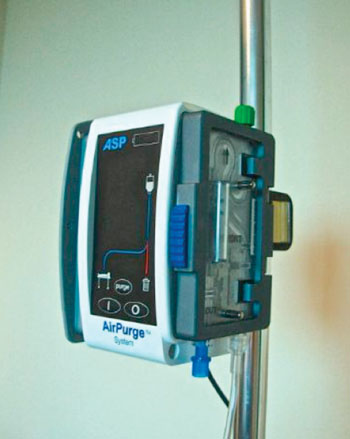Automatic System Purges Bubbles from IV Lines
By HospiMedica International staff writers
Posted on 17 Oct 2014
A new system automatically removes and disposes of air bubbles in intravenous (IV) lines during the administration of solutions, blood, and blood products.Posted on 17 Oct 2014
The AirPurge System is a novel device that unobtrusively monitors the IV line attached to the device for any air bubbles, which are then diverted to a built-in reservoir and are disposed of in a single-use, disposable collection bag. The device does not require any manual intervention, thereby minimizing interruption and delays for medical staff in the operating room (OR) or post-anesthesia care unit (PACU). Patented technology activates and confirms the air purging process, and automatically reverts back to free flowing fluid within milliseconds.

Image: The AirPurge system for IV line air bubble detection and removal (Photo courtesy of Anesthesia Safety Products).
The AirPurge System is designed to remove air bubbles from IV lines as small as 25 µL at high (600 mL/min) or low infusion rates. The system can be easily integrated into an IV setup routine by installing it on the IV pole just below a fluid/blood warmer to capture smaller air bubbles that are typically generated during the infusate heating process. The AirPurge System is a product of Anesthesia Safety Products (ASP: Woburn, MA, USA), and has been approved by the US Food and Drug Administration (FDA).
“Hospitals today are always looking to improve patient outcomes,” said Ihsan Haddad, President of ASP. “This device provides clinicians peace of mind while allowing them to focus on other matters in the OR. The device is easy to set-up.”
Small air emboli often get into the blood circulation accidentally during surgery and other medical procedures, but most of these air emboli enter the veins and are stopped at the lungs. For venous air embolisms, death may occur if a large bubble of gas becomes lodged in the heart, stopping blood from flowing from the right ventricle to the lungs. Arterial gas embolism (AGE), on the other hand, is a more serious matter than in a vein, because it may directly stop blood flow to an area fed by the artery. The amount of arterial gas embolism that causes symptoms depends on location; 2 mL of air in the cerebral circulation can be fatal, while 0.5 mL of air into a coronary artery can cause cardiac arrest.
Related Links:
Anesthesia Safety Products














